Related Research Articles

Madurai is a major city in the Indian state of Tamil Nadu. It is the cultural capital of Tamil Nadu and the administrative headquarters of Madurai District. As of the 2011 census, it was the third largest urban agglomeration in Tamil Nadu after Chennai 22nd most populated city in India. Located on the banks of River Vaigai, Madurai has been a major settlement for two millennia and has a documented history of more than 2500 years. It is often referred to as "Thoonga Nagaram", meaning "the city that never sleeps".

C. Subramania Bharati was a Tamil writer, poet, journalist, Indian independence activist, social reformer and polyglot. He was bestowed the title "Bharati" for his excellence in poetry. He was a pioneer of modern Tamil poetry and is considered one of the greatest Tamil literary figures of all time. He is popularly known by his mononymous title "Bharati/ Bharathiyaar," and also by the other title "Mahakavi Bharati". His numerous works included fiery songs kindling patriotism during the Indian Independence movement. He fought for the emancipation of women, against child marriage, vehemently opposed the caste system, and stood for reforming society and religion. He was also in solidarity with Dalits.
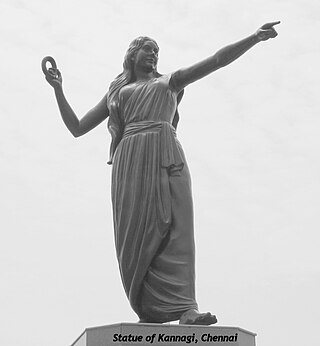
Kannagi, sometimes spelled Kannaki, is a legendary Tamil woman who forms the central character of the Tamil epic Cilappatikaram. Kannagi is described as a chaste woman who stays with her husband despite his adultery, their attempt to rebuild their marriage after her unrepentant husband had lost everything, how he is framed then punished without the due checks and processes of justice. Kannagi proves and protests the injustice, then curses the king and city of Madurai leading to the death of the unjust Pandyan King of Madurai, who had wrongfully put her husband Kovalan to death. The society that had made her suffer, suffers in retribution as the city Madurai is burnt to the ground because of her curse. In Tamil folklore, Kannagi has been deified as the symbol – sometimes as goddess – of chastity, with sculptures or reliefs in Hindu temples iconographically reminding the visitor of her breaking her anklet or tearing her bleeding breast and throwing it at the city.
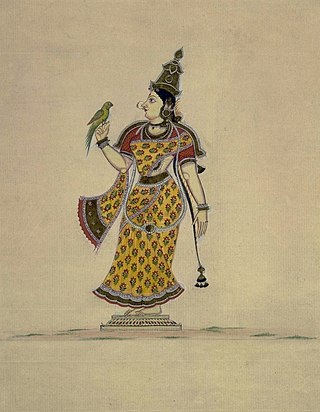
Meenakshi is a Hindu goddess. She is the tutelary deity of Madurai and is considered an avatar of the goddess Parvati. She is the divine consort of Sundareśvarar, a form of Shiva. She finds mention in literature as the queen of the ancient Madurai-based Pandya kingdom, and is later deified. The goddess is also extolled by Adi Shankara as Shri Vidya.

Madurai Veeran, also known as Veeran, is a Tamil folk deity popular in southern Tamil Nadu, India. His name literally means, "warrior of Madurai".

Temple cars or Temple chariots are used to carry representations of Hindu gods around the streets of the temple on festival days. These chariots are generally manually pulled by the devotees of the deity.
Valasaravakkam is a neighbourhood in the Chennai district of the Indian state of Tamil Nadu and a residential suburb of the city of Chennai. It is located in the Maduravoyal Taluk at a distance of approximately 15 kilometres from the Kilometer Zero stone. Valasaravakkam lies on the Arcot Road, one of Chennai's arterial roads. It is under the Maduravoyal election constituency. In October, 2011 Valasaravakkam Municipality ceased to exist and the area became part of Chennai Corporation as Ward Nos 149 and 152, Southern Region, Corporation of Chennai. As of 2011, the town had a population of 47,378. Famous Sivan temple is in Kesavardhini.

Arulmigu Murugan Temple, Thiruparankundram is a Hindu temple dedicated to the god Murugan at Thiruparankundram, Tamilnadu, India. It is regarded as one of the "First Houses of Murugan". The temple uses rock-cut architecture and is believed to have been built by the Pandyas during the 6th century. According to legend, Murugan slayed the demon Surapadman and married his consort Devasena at the temple. Murugan is also said to have worshipped his father Shiva at the site as Parangirinathar.

Arulmigu Meenakshi Sundareswarar Temple a.k.a Arulmigu Meenakshi Amman Thirukkovil is a historic Hindu temple located on the southern bank of the Vaigai River in the temple city of Madurai, Tamil Nadu, India. It is dedicated to the goddess Meenakshi, a form of Shakti, and her consort, Sundareshwarar, a form of Shiva. The temple is at the centre of the ancient temple city of Madurai mentioned in the Tamil Sangam literature, with the goddess temple mentioned in 6th-century CE texts. This temple is one of the Paadal Petra Sthalams, which are 275 temples of Shiva that are revered in the verses of Tamil Saiva Nayanars of the 6th-9th century CE.
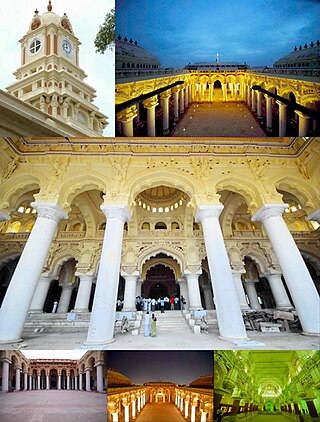
Thirumalai Nayak Palace is a 17th-century palace erected in 1636 by King Tirumala Nayaka, a king of Madurai's Nayaka dynasty who ruled Madurai from 1623 to 1659, in the city of Madurai, India. The building, which can be seen today, was the main palace, in which the king lived. The original palace complex was four times bigger than the present structure. In its heyday, the palace was considered to be one of the wonders of the South. The palace is located two kilometres (1.2 mi) south east of the Meenakshi Amman Temple.
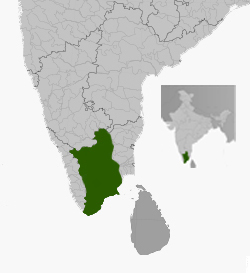
The Madurai Nayaks were a Telugu dynasty who ruled most of modern-day Tamil Nadu, India, with Madurai as their capital. The Madurai Nayaks had their origins in the Balija Chetti merchants clans of present-day Andhra Pradesh. The Nayak reign which lasted for over two centuries from around 1529 to 1736 was noted for its achievements in arts, cultural and administrative reforms, revitalization of temples previously ransacked by the Delhi Sultans, and the inauguration of a unique architectural style.

Palaiyakkarars, or Poligar, Palegara in Andhra, Karnataka and Tamil Nadu refers to the holder of a small kingdom as a feudatory to a greater sovereign. Under this system, palayam was given for valuable military services rendered by any individual. The word pālayam means domain, a military camp, or a small kingdom. This type of Palayakkarars system was in practice during the rule of Pratapa Rudhra of Warangal in the Kakatiya kingdom. The system was put in place in Tamil Nadu by Viswanatha Nayak, when he became the Nayak ruler of Madurai in 1529, with the support of his minister Ariyanathar. Traditionally there were supposed to be 72 Palayakkarars. The majority of those Palaiyakkarar, who during the late 17th- and 18th-centuries controlled much of the Telugu region as well as the Tamil area, had themselves come from the Kallar, Maravar and Vatuka communities.
Sacchidananda Bharati I , was a Hindu sant and religious leader of the 17th century. He was the Jagadguru of the Hindu matha Sringeri Sharada Peetham from 1623 to 1663, and is believed to have saved it from attack by spiritual means.

The Thanjavur Maratha kingdom ruled by the Bhonsle dynasty was a principality of Tamil Nadu between the 17th and 19th centuries. Their native language was Thanjavur Marathi. Venkoji was the founder of the dynasty.
Nakkīraṉãr, sometimes spelled Nakkirar or Nakkiranar, was a post-Sangam era Tamil poet. He is credited with the devotional poem to the Hindu god Murugan in the Pattuppāṭṭu anthology, titled Tirumurukāṟṟuppaṭai. In the historic Tamil tradition, he is believed to have also authored a second poem in the Sangam collection titled Neṭunalvāṭai, as well as a detailed commentary on Iraiyanar Akapporul. However, according to the Tamil literature scholar Kamil Zvelebil, the Tirumurukāṟṟuppaṭai and the Neṭunalvāṭai were likely authored by two different Nakkirar, and Nakkīraṉãr and the older Nakkīrar were different individual. It is uncertain as to which century Nakkiranar lived, much like the chronology of the Sangam literature. Scholars variously place his works between 3rd and 8th century CE, with Zvelebil suggesting late classical.

The Meenakshi Tirukalyanam festival, also known as Chithirai Tiruviḻa or Meenakshi Kalyanam, is an annual Tamil Hindu celebration in the city of Madurai during the month of April. The festival, celebrated during the Tamil month of Chithirai, is associated with the Meenakshi Temple, dedicated to the goddess Meenakshi, a form of Parvati and her consort Sundareshvara, a form of Shiva.
Ariyanatha Mudaliar was the Delavoy (General) and the Chief Minister of the greatest of the Nayaka domains established by the Vijayanagar viceroy and later ruler of Madurai, Viswanatha Nayak (1529–64). He assisted in running a quasi-feudal organisation of regions called the poligar or the palayakkarar system where the regions are divided into palayams and are independently governed by poligars or palayakkarars.
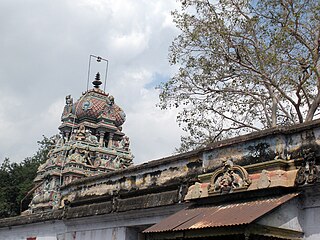
Thiru Aappanoor is a Hindu temple of the god Shiva in Sellur,Madurai, India. The Pandya Kings and the Royal Sethupathi kings made many contributions to this temple. It is one of the shrines of the 275 Paadal Petra Sthalams.

Vandiyur Mariamman Teppakulam is a temple tank located near to Vandiyur Mariamman Temple and situated at a distance of about 5 km from the Meenakshi Amman Temple. Literally, Teppakulam means temple pond mainly used for devotional festivals.

The Hindu Religious and Charitable Endowments Department of the Government of Tamil Nadu manages and controls the temple administration within the state. The Tamil Nadu Hindu Religious and Charitable Endowments Act XXII of 1959 controls 36,425 temples, 56 mathas or religious orders, 1,721 specific endowments and 189 trusts.
References
- ↑ Atyar, N Natesa. Preface to Ananda Sagara Stavam.
- ↑ "Scholars pay tribute to advaita acharyas". The Hindu. 5 February 2015.